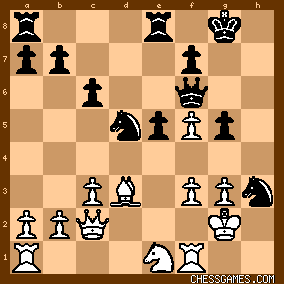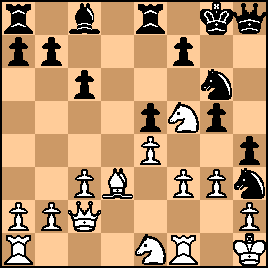| Feb-21-05 | | chess man: I like that note <!> by Capablanca. |
|
| Jul-05-05 | | THE pawn: Are you sure it's not Nimzowitsch who did the exclamation mark? |
|
| Sep-29-06 | | Sleeping kitten: "What remains needs few remarks." Then why does Capablanca, at the 23rd move, exchange an enormous knight against a microscopic bishop without future ? Shereshevsky says the white bad bishop, in fact, supports White's kingside pawns. After the exchange, the black bishop will be stronger than the white knight. With this and the control of the open file, White's position collapses. In fact, this game anticipates 22 Nxd7+! in Fischer vs Petrosian, 1971 ! At the 29th move, Nimzowitsch asks "Why not Bxg4 ?" and Chernev answers (in Capablanca's Best Chess Endings) 29...Bxg4 30 Nxh4 gxh4 31 Rg2. |
|
| Sep-29-06 | | technical draw: I am N Klined to believe white played poorly. |
|
| Dec-02-06 | | Calli: Yeah, except I'm n-klined to think this is Dr Harry Kline, a good local NY player for several decades. He finished 10th out of 14 at this tourney (NY Masters 1913). |
|
| Sep-09-09 | | roastedrook: great annotation by Nimzo, he makes feel as If I was there on the board, analyzing positions and predicting moves ahead .. gg Capa |
|
Sep-25-10
 | | Fusilli: In these annotations, Nimzowitsch gives the line 22.Nf5 hxg3 23.hxg3 Bxf5 24.exf5 Ne7 25.Kg2:
click for larger viewAnd here he gives 25...Kg7 for Black, who loses a piece and ends up lost, and asks: is the pawn sacrifice 25...g4 26.fxg4 Ng5 any better? Well, I'd say "of course it is!" Maybe I am missing something, but I prefer to lose a pawn to losing the piece. |
|
| Apr-21-12 | | bystander: 10. 0-0. What about waiting with castling and see how black wants to develop? E.g. 10.h3 ♘h5 11.♗h2 ♘f4 12.♗f4x ef4x 13.0-0-0 ♘f8. |
|
| Apr-21-12 | | bystander: 13. de5x. Is white really forced to this exchange? Can't white postpone this move, for example. 13.♗h4 ♘g6 14.♗f6x ♗f6x 15.♖fe1 ♗d7 16.♖ad1 ♖ad8 17.a4. |
|
| Apr-21-12 | | bystander: 16.Ne1. I assume the intention of this move is to give g2 some extra protection. Maybe this can also be achieved with the bishop. For example. 16.♖fd1 ♘f4 17.♗f1 ♗e6 18.♘d2 ♖ad8 19.♘dc4. |
|
| Apr-21-12 | | bystander: 19.N3g2. 19.♕e2 looks better to me. 19.♕e2 h4 20.♘1g2 ♘g6 21.♘f5. |
|
| Apr-22-12 | | bystander: <Sep-25-10. Fusilli: In these annotations, Nimzowitsch gives the line 22.Nf5 hxg3 23.hxg3 Bxf5 24.exf5 Ne7 25.Kg2:And here he gives 25...Kg7 for Black, who loses a piece and ends up lost> I was not so impressed bij 25...Kg7 either. 25...Nd5 (pressure on e3 and f4) looks better for black. Maybe black has to sacrifice a pawn, but is does not look to bad. 25...♘d5 25.♕d3 g4 26.fg4x e4 27.♗c4 e3 28.♕e2 ♘e2. But is 22. ♘f5 really the best line for white? I have been looking to lines which start with 25.Kg2. I think that black keeps a small advantage. For example: 25.♔g2 hg3x 26.hg3x ♔g7 27.♖h1 ♖h8 28.♖d1 g4. |
|
| Apr-22-12 | | bystander: 34) Nc2. Better looks 34.♘f5 ♖d7 35. ♖g1 (to attack h3 and the black king). My computer prefers 33)... ♕f4 or ♕e7 for black, but I do not understand why. |
|
Apr-23-12
 | | Fusilli: <bystander: ... Maybe black has to sacrifice a pawn, but is does not look to bad. 25...Nd5 25.Qd3> 25.Qd3 is not possible. There is a white bishop on d3, right? (I believe that is the position from my earlier diagram.) |
|
| Apr-24-12 | | bystander: <Apr-23-12 Fusilli: <bystander: ... Maybe black has to sacrifice a pawn, but is does not look too bad. 25...Nd5 25.Qd3> Sorry fot that. The line how it supposed to be is {25...Nd5 26. Qd2 g4 27. fg4x e4 28. Lc4 e3 29. Qe2 Ne2). A little bit to much of typos. |
|
May-07-12
 | | Fusilli: <bystander> Yes, that looks totally playable for Black. (I am sure you meant 29...Nf2, not Ne2, as the last move in your line). Also interesting, in this position, which results from your analysis after 22.Nf5 hxg3 23.hxg3 Bxf5 24.exf5 Ne7 25.Kg2 Nd5 26.Qd2: 
click for larger viewThe Tal-like sac 26...Nhf4+ is pretty interesting. It leads to a sharp game of incalculable outcome (that's why I say "Tal-like"). |
|
| Apr-07-21 | | NISCHONE: Actyally Stockfish says that Capablanca blundered the game on 44....b3?? and with 45. Nf2 Kleine could have drawn, but actually he replied with another blunder 45. Qe8+?? |
|
May-03-22
 | | kingscrusher: Nimzovich's ridiculously over-optimistic human annotations are a great reminder that Humans are just tourists in the game of chess. Nf5 in his analysis is certainly not winning for White objectively. Even if we follow Nimzovich's ridiculous line with Bxf5 giving White potentially more dangers, there is an amazing resource Nd5 which saves the day for Black with respect to the knight on h3: Harry Kline - Jose Raul Capablanca 0-1 7.0, American National 1913

click for larger viewAnalysis by Stockfish 15 - 3 threads max:
1. ⩱ (-0.53): 26.Qd2 Ndf4+ 27.gxf4 Nxf4+ 28.Kg3 Rad8 29.Rd1 c5 30.Rh1 e4 31.fxe4 c4 32.Qh2 cxd3 33.Qh7+ Kf8 34.Rh6 Qe5 35.Qh8+ Qxh8 36.Rxh8+ Kg7 37.Rxe8 Rxe8 38.Nf3 Nh5+ 39.Kf2 Rxe4 Nd5 sets up Ne3 which takes out g2 key escape square which means in some lines the White King ends up getting mated after winning the knight on h3. |
|
| May-03-22 | | FM David H. Levin: I was surprised that in analyzing 22. Nf5, Nimzovich doesn't mention 22...Qh8, given his appreciation for what might seem to be eccentric piece placement. 
click for larger viewAfter 23. Kg2 hxg3 24. hxg3 Ngf4+, Black's queen can enter White's position more readily than in his line. (I analyze this in an entry on my Q&A page of my website, where I just realized I misspelled the name of the player who had White.) |
|





